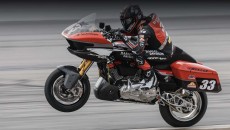The Grand Prix Commision, the body comprised of Dorna, FIM, IRTA and MSMA that decides on the grand prix motorcycle racing world championship rules, met in Madrid recently to make some changes.
The meeting focused on various items. Here is a summary of the decisions taken.
GOODBYE INTERMEDIATES - As the Michelin managers had already mentioned in recent months, from 2017, the MotoGP riders will no longer have intermediate tyres available. Dorna had requested this particular compound in order to allow the bikes to lap even in damp track conditions. Most of the riders, however, were never very enthusiastic about it.
Another change: the maximum number of wet and dry track tyres remains unchanged but there is an additional specification of front and rear dry slick tyres available to choose.
DUMMY CAMERAS AND HEAVIER MOTO2 BIKES - The top six riders in Moto3 and Moto2 are required to carry on board cameras. It is considered that the additional weight involved in classes where machine performance is so equal could disadvantage riders required to carry the cameras. For this reason, it will now be a requirement for other machines not equipped with actual cameras to carry dummy versions or weights, in the same positions.
Furthermore, in the Moto2 class the minimum weight will be increased by two kilos to 217 kilos.
10 DAYS OF TESTING FOR MOTO3 AND MOTO2 - Teams may test with any contracted rider at any circuit for a maximum of ten days per rider during the season, in addition to official tests and tests in November after the last event. They will be able to choose any circuit on which to use these days.
PENALTIES FOR SPEEDERS - Those who exceeded the pit lane speed limit were fined a €150 penalty, but this measure proved to be an insufficient deterrent. From next year, the fine for the first offence will be €200.00 but second and subsequent offences can be penalised with larger fines or other penalties determined, according to circumstances, by the FIM MotoGP Stewards.
START AND RESTART PROCEDURES - Any rider who arrives at the grid behind the safety car after completing his warm up lap must now enter the pit lane and start the race from the pit lane exit.
When a race is interrupted after less than three laps have been completed, all riders may start, including riders who might not have completed the sighting or warm up lap for the original start.
CLEANING RULES - It is no longer permitted for track marshals to clean the track or alter the condition of the racing surface without prior instructions or authorisation from the Race Director and the Safety Officer.
INTRODUCING APPEAL STEWARDS - The name makes this figure seem more mysterious than it really is. This is a pair of Stewards who will be appointed hear appeals against any decisions of the FIM MotoGP Stewards. This means that in virtually all cases results and sanctions can be confirmed or annulled during the event.
MEDICAL ISSUES - The FIM Medical Officer will be given more power and responsibility to ensure that medical facilities and staff are adequate and competent to deal with injured riders.
Injured riders have the right to have confidentiality respected about their condition. Medical staff or race officials are no longer authorised to make statements to any third party, other than immediate relatives, about the condition of injured riders without the authorisation of the FIM and Dorna.
Riders will now be responsible for notifying the relevant FIM Medical Officer and the CMO of any injury or illness that might affect his/her ability to ride or compete.









